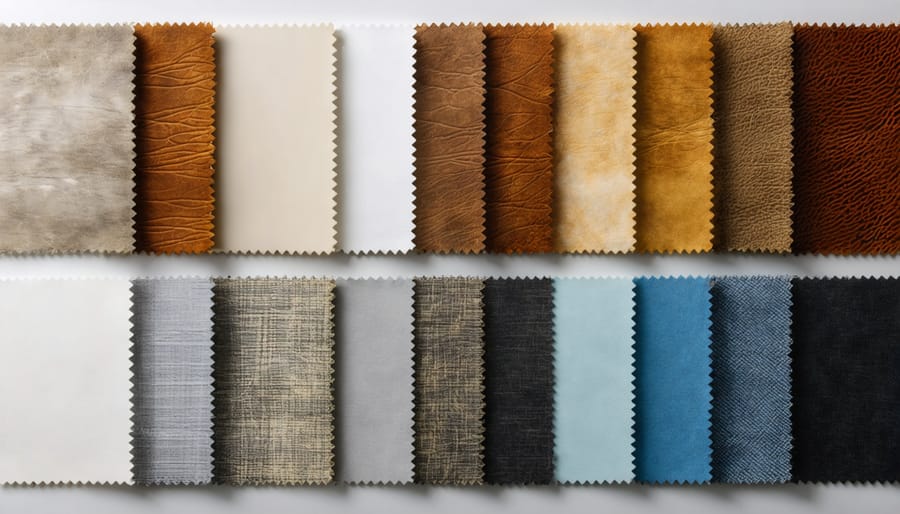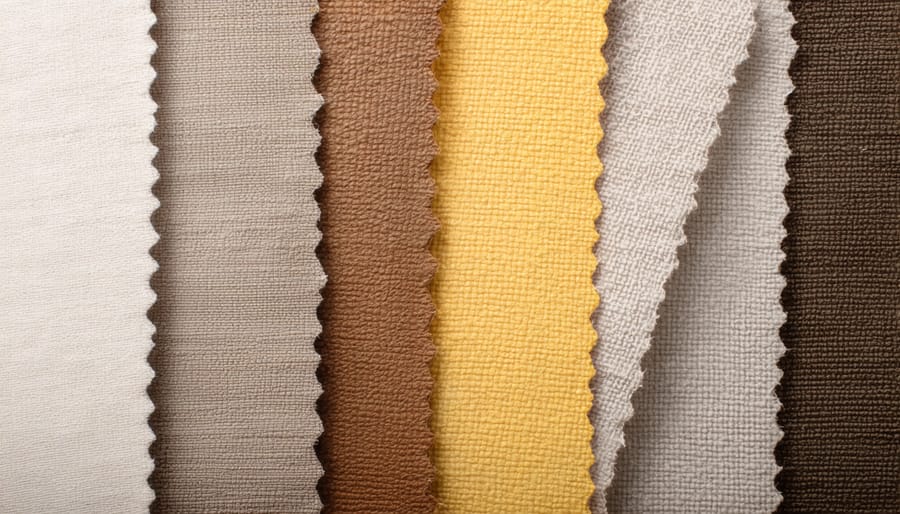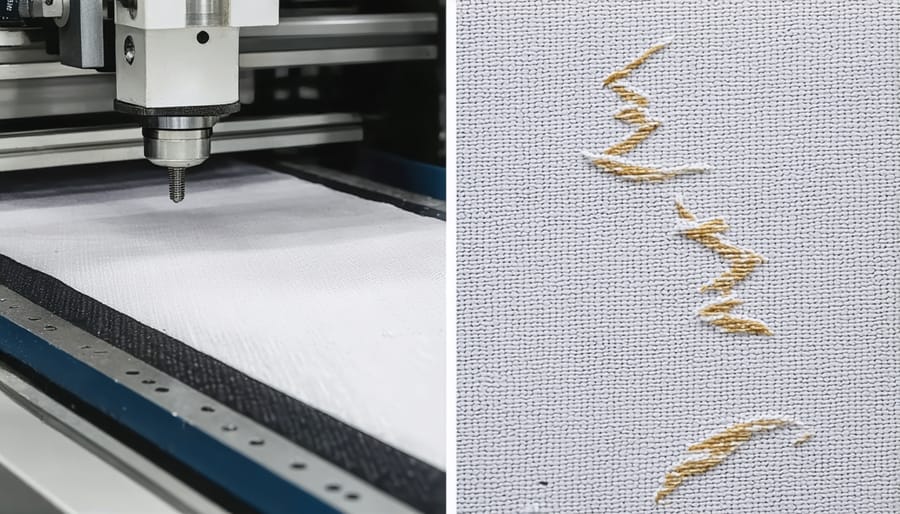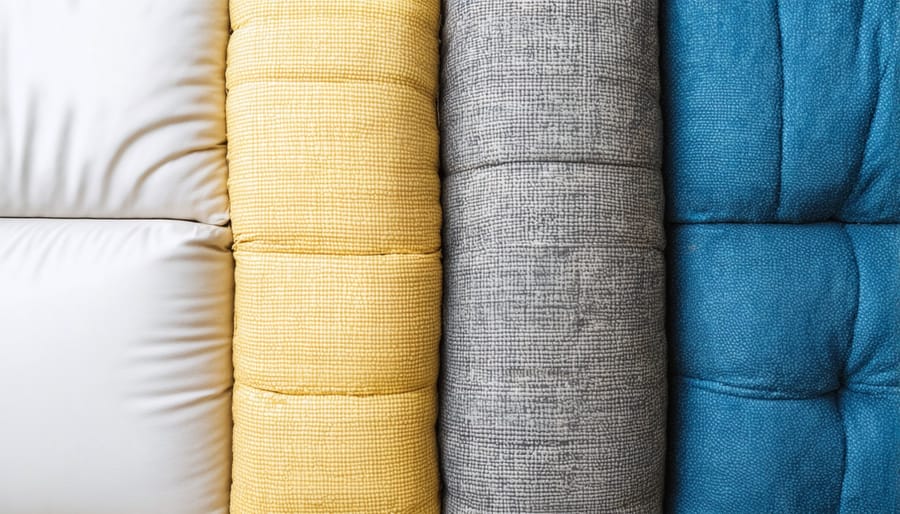
Transform your furniture’s look and longevity by selecting the perfect upholstery material, a critical decision that impacts both aesthetics and durability. Modern upholstery fabrics range from luxurious leather and velvet to performance-tested synthetics, each offering unique benefits for different lifestyles and applications. Whether refreshing a beloved family heirloom or updating commercial seating, understanding material characteristics helps ensure successful upholstery repair techniques and long-term satisfaction. Today’s market offers innovative options that combine style with practical features like stain resistance, fade protection, and easy maintenance – essential considerations for any upholstery project. This guide explores the most popular upholstery materials, their specific advantages, and how to choose the perfect fabric for your unique needs and environment.
Natural fibers remain a popular choice for furniture upholstery, offering both aesthetic appeal and practical benefits. Cotton stands out as a versatile option, providing excellent breathability and comfort while being naturally hypoallergenic. Its durability makes it ideal for everyday use, though it may require regular cleaning to maintain its appearance.
Linen, derived from the flax plant, brings a sophisticated look to furniture with its distinctive texture and natural sheen. While it offers superior coolness and moisture-wicking properties, it tends to wrinkle easily and may require professional cleaning to maintain its pristine appearance.
Wool upholstery delivers exceptional durability and natural resistance to staining, making it perfect for high-traffic areas. Its natural elasticity helps maintain shape over time, while its fire-resistant properties add an extra layer of safety. The material’s warmth and comfort make it particularly suitable for colder climates.
Leather represents the pinnacle of natural upholstery materials, offering unmatched durability and a timeless appeal that often improves with age. Quality leather furniture can last for decades with proper leather maintenance and repair. It’s naturally resistant to dust mites and allergens, making it an excellent choice for households with allergy concerns.
Each natural fiber option brings its unique characteristics to furniture pieces, allowing homeowners to select materials that best match their lifestyle needs, maintenance preferences, and aesthetic goals. When properly cared for, these materials can maintain their beauty and functionality for many years, making them a worthy investment for any home.

Synthetic materials have revolutionized the furniture upholstery industry, offering durability and versatility that natural fibers sometimes can’t match. Polyester leads the pack as the most widely used synthetic fabric, prized for its exceptional strength and resistance to wrinkles, fading, and everyday wear. It’s particularly suitable for high-traffic areas and homes with children or pets, as it repels most stains and cleans easily with standard household products.
Nylon, another popular synthetic option, brings outstanding durability and elasticity to upholstery applications. Its resilient fibers bounce back to their original shape, making it ideal for frequently used furniture pieces. While slightly more expensive than polyester, nylon’s longevity often justifies the investment, especially in commercial settings where furniture endures constant use.
Performance fabrics represent the latest innovation in synthetic upholstery materials. These engineered textiles, such as Sunbrella and Crypton, combine the best qualities of traditional synthetics with advanced technology. They feature built-in stain resistance, moisture repellency, and UV protection, making them perfect for both indoor and outdoor furniture. Many performance fabrics are also designed to resist mold and mildew, a significant advantage in humid climates.
When selecting synthetic upholstery, consider the fabric’s double rub count – a measure of durability that indicates how many times the material can be rubbed before showing wear. Most synthetic materials offer impressive double rub counts exceeding 50,000, making them excellent choices for long-term use. Additionally, many modern synthetics are manufactured with eco-friendly processes and can be recycled, addressing growing environmental concerns while maintaining superior performance characteristics.
When selecting upholstery material, understanding durability ratings is crucial for making an informed decision. The industry standard for measuring fabric durability is the “double rub count,” which simulates the wear and tear of someone sitting down and getting up from furniture repeatedly.
For residential use, fabrics with 15,000 to 25,000 double rubs are generally suitable for everyday use. However, high-traffic areas or homes with children and pets may benefit from fabrics rated at 30,000 double rubs or higher. Commercial spaces typically require materials rated at 50,000 double rubs or more to withstand constant use.
Here’s a quick reference guide for double rub recommendations:
– Light Use (decorative): 6,000-9,000
– Light Duty: 9,000-15,000
– Medium Duty: 15,000-25,000
– Heavy Duty: 25,000-30,000
– Extra Heavy Duty: 30,000+
Beyond double rub counts, many manufacturers also provide wear ratings using terms like “light duty” through “extra heavy duty.” These ratings consider additional factors such as pilling resistance, colorfastness, and seam strength. Some materials may even carry specific certifications for commercial use or flame resistance.
Remember that these ratings serve as guidelines rather than guarantees. Factors like proper maintenance, exposure to sunlight, and cleaning methods will ultimately impact how well your upholstery material performs over time.

When selecting upholstery materials, your lifestyle plays a crucial role in determining the best choice for your furniture’s longevity and maintenance. For households with children, stain-resistant fabrics like treated polyester or microfiber offer practical solutions that withstand spills and frequent cleaning. These materials are also budget-friendly and maintain their appearance with minimal care.
Pet owners should prioritize durable, tightly woven fabrics that resist claw marks and pet hair. Leather and performance fabrics are excellent choices, as they’re easy to clean and don’t trap pet dander. However, if you have cats, consider avoiding loose weaves or delicate materials that can snag easily.
The room’s purpose also influences material selection. High-traffic areas like living rooms benefit from resilient materials such as solution-dyed acrylic or polyester blends. For formal spaces used occasionally, you might opt for more delicate fabrics like silk or linen, which require gentler care but offer elegant aesthetics.
Consider your cleaning preferences and available time for maintenance. Some materials, like velvet, require regular brushing and professional cleaning, while synthetic fabrics often need only occasional vacuuming and spot cleaning. If you prefer low-maintenance options, look for materials with built-in stain resistance or those that can be cleaned with simple household products.
Climate and sun exposure should also factor into your decision. Rooms with direct sunlight need fade-resistant materials, while humid environments require fabrics treated to resist mold and mildew.
When selecting upholstery fabric, achieving harmony between the material and your furniture’s style is crucial for a cohesive look. For traditional pieces with ornate woodwork, consider rich velvets, damasks, or subtle textured weaves that complement the furniture’s classic character. Contemporary furniture often pairs well with sleek, solid-colored fabrics or bold geometric patterns that enhance their modern aesthetic.
Pattern scale is particularly important – larger furniture pieces can handle bigger patterns, while smaller items look better with subtle or small-scale designs. When mixing patterns, follow the rule of three: combine a large-scale pattern, a medium geometric design, and a small coordinating print while maintaining a consistent color palette.
Texture adds depth and visual interest to your furniture. Smooth, tight weaves work well in formal settings, while nubby textures create a casual, inviting atmosphere. Consider the room’s existing textiles, including curtains, rugs, and throw pillows, to ensure your upholstery choice creates a balanced environment.
Color selection should reflect both personal taste and practical considerations. Light colors open up spaces but show wear more easily, while darker hues hide stains better but may overwhelm smaller rooms. For timeless appeal, choose main furniture pieces in neutral tones and add color through accent pieces that can be easily updated as trends change.
Remember to request fabric samples and view them in your space’s natural lighting before making a final decision, as colors and textures can appear different under various lighting conditions.
Different upholstery materials require specific cleaning approaches to maintain their appearance and extend their lifespan. For natural fabrics like cotton and linen, regular vacuuming and prompt spot cleaning with water-based solutions work best. Always test cleaning products on a hidden area first to ensure colorfastness.
Synthetic materials such as polyester and nylon are more forgiving and can typically withstand stronger cleaning agents. However, it’s essential to avoid harsh chemicals that might break down the fibers. For these materials, a mixture of mild detergent and warm water usually suffices for most stains.
Leather upholstery demands special care. Use leather-specific cleaners and conditioners to prevent cracking and maintain suppleness. Never use standard household cleaners on leather, as they can cause permanent damage. For regular maintenance, simply wipe with a slightly damp cloth.
Velvet and microfiber require gentle handling. Use a soft brush attachment when vacuuming and address spills immediately by blotting – never rubbing – the affected area. For stubborn stains, consider DIY upholstery repair solutions designed specifically for these delicate materials.
Professional cleaning is recommended annually for all upholstery types, regardless of visible soiling. This helps prevent dirt buildup and extends the fabric’s life while maintaining its original appearance and texture.

Regular maintenance is key to preserving the beauty and durability of your upholstery materials. Start by implementing a weekly vacuuming schedule using a soft brush attachment to remove dust and debris before they settle deep into the fabric. For leather upholstery, dust with a clean, dry cloth and avoid using water-based cleaners unless specifically designed for leather care.
Protection from direct sunlight is crucial as UV rays can cause fading and material degradation. Consider using window treatments or rotating furniture periodically to ensure even wear. When spills occur, act quickly by blotting – never rubbing – the affected area with a clean, white cloth. For stubborn stains or to repair common upholstery damage, consult professional services to prevent further deterioration.
Apply fabric protectors specifically designed for your upholstery type to create a barrier against stains and spills. Regular professional cleaning every 12-18 months helps maintain the material’s integrity and extends its lifespan. For daily protection, consider using throws or slipcovers in high-traffic areas or homes with pets.
Keep the room’s humidity levels between 40-60% to prevent material degradation and maintain proper ventilation to avoid musty odors. These preventive measures will help ensure your upholstery remains beautiful and functional for years to come.
Selecting the right upholstery material for your furniture is a crucial decision that impacts both aesthetics and functionality. We’ve explored various fabric options, from durable synthetics to luxurious natural fibers, each offering unique benefits for different lifestyles and needs. Remember to consider factors such as durability, maintenance requirements, and intended use when making your selection.
For high-traffic areas and homes with children or pets, performance fabrics and synthetic blends offer excellent stain resistance and longevity. Natural fibers like cotton and linen bring timeless elegance and breathability, making them ideal for formal spaces and moderate-use furniture. Leather remains a premium choice, offering both sophistication and durability when properly maintained.
Before making your final decision, we recommend ordering fabric samples to test in your space and examining them under different lighting conditions. Consider consulting with a professional upholsterer who can provide expert guidance based on your specific furniture piece and usage requirements. With proper care and maintenance, your chosen upholstery material will provide years of comfort and beauty while protecting your furniture investment.
Ready to start your reupholstery project? Contact a local professional or visit a fabric retailer to explore your options in person.